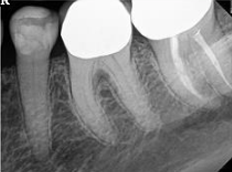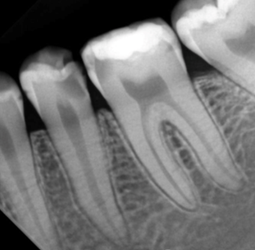
How to avoid claim denials for crowns, pt. 2
Last month, we discussed ways in which your claims for crowns might get denied. But what about core buildups, posts and cores, crown lengthening, and temporary crowns? Most often, the issue is a lack of documentation and radiographs. Here’s a closer look at why your claims might be getting denied.
Core build-up, including any pins when required (D2950)
For core buildups, you need to submit a preoperative periapical radiograph and written report. Unobstructed, periapical x-rays are required to assess the periapical health of the tooth.
Under Delta Dental’s processing policies, Delta Dental can make an allowance for a core build-up when there is extensive loss of tooth structure, documented in radiographic images or a narrative report, or when dental history suggests that it’s needed, such as following root canal treatment.
If you report performing a buildup when the procedure only involves a filler to eliminate an undercut, box form, or concave irregularity in the preparation, the procedure should be included in the crown prep, according to the American Dental Association.
- A core build-up is generally needed when the following conditions are met:
- A major part of the tooth’s structure (50% or more) is fractured or carious.
- The preparation is at or below the gingival crest.
Less than 3 mm of sound dentin remains vertically above the preparation line in opposing walls where the crown margins will be located.
In the following example, a preauthorization was submitted for a build-up on tooth #19. The preoperative radiographic image doesn’t show existing root canal treatment or an extensive amount of recurrent decay, and the amount of decay or existing tooth structure beneath the existing crown can’t be determined. This build-up claim was denied because we can’t see the tooth structure underneath the existing crown on the x-ray.
Since we can't determine the amount of tooth that has been lost underneath the crown, the buildup will be included in the fee for the crown. You’ll need to submit additional documentation (intraoral images or x-rays taken once the crown is removed) to support payment of the buildup with the paid claim.

In this next example, which was submitted with a claim for buildups on teeth #19 and #20 and approved, the preoperative radiographic image depicts an extensive loss of tooth structure (at least 50%) due to decay.

Top denial codes for core buildups
The codes most often associated with build-up denials are the following:
- 5BU. The documentation doesn’t show a significant loss of tooth structure. The fee for the build-up is included in the fee for the completed restoration.
- 5RX. We couldn’t determine benefits because the submitted radiograph does not depict the entire tooth.
- 570. We couldn’t determine benefits because of missing preoperative periapical radiographic images.
- 5L8. We couldn’t determine benefits because of missing preoperative periapical radiographic images.
- 564. Submit a clinical treatment narrative.
Prefabricated post and core in addition to crown (D2954) and post and core in addition to crown, indirectly fabricated (D2952)
Prefabricated and lab fabricated post and core procedures are payable only on an endodontically treated tooth. They are allowable for anterior teeth only when there isn’t enough tooth structure remaining to support a cast restoration.
Unobstructed, periapical x-rays are required to assess the periapical health of the tooth.
When radiographs show that more than half of the coronal tooth structure remains, fees for a post and core are included in the fee for the restorative procedure. You may not charge a separate fee to the patient or Delta Dental.
We won’t make an allowance for a post and core when radiographs indicate an absence of endodontic treatment, incompletely filled canal space or unresolved pathology associated with the involved tooth. As with the above example, you may not charge a separate fee to the patient or Delta Dental.
The fee for procedure D2954 includes the post and any core build-up/substructure. For example, when you bill for D2954, any composite, amalgam or build-up is included in the fee for D2954 and may not be billed separately.
Top denial codes for posts and cores
The codes most often associated with post and core denials are:
- 9WA. The fee for this procedure is included in the fee for another service.
- 7C2. We can’t pay the submitted procedure due to the absence or conflict of a related service that is in this patient’s record.
- 5C2. Based on the documentation, the long-term prognosis of the tooth is questionable due to unresolved periapical or periradicular pathology.
- 5B3. Based on the documentation, the long-term prognosis of the tooth is questionable due to unresolved periapical or periradicular pathology of the existing root canal.
- 5E3. Based on the documentation, the long-term prognosis of the tooth is questionable because the placement, density or depth of the existing root canal filling material doesn’t adequately create a seal.
Clinical crown lengthening – hard tissue (D4249)
Delta Dental considers the fee for preparation of the gingival tissue for placing a crown to be included in the fee for the crown. When you perform procedure D4249 on the same day you prepare the crown, you may not charge a separate fee for D4249 to the patient or Delta Dental.
Before you complete a restoration of a tooth, wait at least four weeks after the clinical crown lengthening.
Top denial code for crown lengthening
The denial code most often associated with crown lengthening submitted in conjunction with a crown is 9WA (the fee for this procedure is included in the fee for a completed service).
Interim crown – further treatment or completion of diagnosis necessary prior to final impression (D2799)
The fee for a temporary, interim or provisional crown is included in the fee for the permanent crown or cast restoration. Long-term cases needing provisional restorations that will be in place for six months or longer may be allowed based on an individual basis.
Top denial code for interim crowns
The denial code most often associated with an interim crown is 9WA (the fee for this procedure is part of the fee for a completed service).
Check your documentation
To speed up processing and to make sure we can determine coverage for buildups, posts and cores, and temporary crowns, always review any associated criteria and submit mounted and dated x-rays or supporting documentation.
Please refer to the submission requirements table on pages 4-1 through 4-3 of the 2022 Claims Processing Policies and Procedures Handbook, available in the Dentist Handbook to see what documentation and clinical information we need for specific procedure codes. You can also refer to the specific procedure code in the handbook for more details about the description of procedures.
Please don’t submit original radiographic images if they are the only diagnostic record for your patient. You can submit duplicate radiographs or radiographic image copies of diagnostic quality, including paper copies of digitized images. We can’t return radiographic images or other documentation submitted with paper claims. However, we will make an exception if you send us a stamped, self-addressed envelope with the claim.
If you have a unique case, please provide a full description and any supporting documentation to help our staff determine benefits. During a clinical review of claims and pre-treatment estimates, Delta Dental can request radiographic images and documentation for procedures that may not initially need any documentation.
CDT coding and nomenclature are the copyright and a trademark of the American Dental Association, all rights reserved.
Recent posts
- Delta Dental is partnering with dental schools to offer exclusive CE courses
- Drive better patient experiences with benefit conversations
- Offer care beyond the chair with teledentistry
- Healthy mouths begin with hygienists
- How to educate patients and make them partners in oral health
- Dr. Justin Perdichizzi — serving those who served
- Get your patients to make (and keep) their dental appointments
- One sign-on, many advantages
- Delta Dental hosts in-person Provider Advisory Council in Arizona
- Tooth be told, we love our dentists
